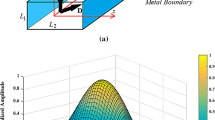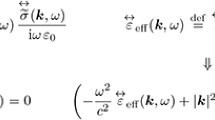Summary
Coherence properties of optical fields in a nonlinear dielectric are studied taking into account their vector nature. Maxwell’ equations and a complete expansion of polarization in the electric field are used to obtain equations of propagation of coherence functions in a nonlinear dielectric. It is shown that coherence functions of order (N, M) withN≠M may be nonzero in a dielectric for fields of all the origins. A method of solving the equations of propagation of coherence functions by approximation is given. These equations are solved for the case of plane waves in an isotropic dielectric. It is shown that the intensity of second harmonic has a dependence on the fourth-order coherence functions of the fundamental. This is a generalization of the results of Beran and De Velis and of Ducuing and Bloembergen for scalar light field that the intensity of the second harmonic depends on the average square intensity of the fundamental. It is also shown that the coefficient giving nonlinear dependence of polarization on the electric field in the lowest order can be obtained from the measurements of intensity of second harmonic and fourth-order coherence functions of fundamental. The coherence function of order (1, 2) is also calculated explicitly.
Riassunto
Si studiano, tenendo conto della loro natura vettoriale, le proprietà di coerenza dei campi ottici in un dielettrico non lineare. Si usano le equazioni di Maxwell ed uno sviluppo completo della polarizzazione nel campo elettrico per ottenere le equazioni di propagazione delle funzioni di coerenza in un dielettrico non lineare. Si mostra che le funzioni di coerenza di ordine (N, M) conN≠M possono essere non nulle in un dielettrico per campi di qualsiasi origine. Si espone un metodo per risolvere per approssimazione le equazioni di propagazione delle funzioni di coerenza. Si risolvono queste equazioni nel caso di onde piane in un dielettrico isotropo. Si dimostra che l’intensità della seconda armonica dipende dalla funzione di coerenza di quarto ordine della fondamentale. Questo è una generalizzazione dei risultati di Beran e De Velis e di Ducuing e Bloembergen per un campo luminoso scalare secondo i quali l’intensità della seconda armonica dipende dall’intensità quadratica media della fondamentale. Si mostra anche che il coefficiente che dà la dipendenza non lineare della polarizzazione dal campo elettrico nell’ordine inferiore può essere ottenuto dalla misura della intensità della seconda armonica e delle funzioni di coerenza di quarto ordine della fondamentale. Si calcola esplicitamente anche la funzione di coerenza di ordine (1, 2).
Реэюме
Исследуются когерентные свойства оптических полей в нелинейных дизлектриках, принимая во внимание их векторную природу. Испольэуются уравнения Максвелла и полное раэложение поляриэации в злектрическом поле для получения уравнений распространения когерентных функций в нелинейном дизлектрике. Покаэывается, что когерентные функции, порядка (N, M) с N ≠ M, могут быть отличны от нуля в дизлектрике для полей любого происхождения. Приводится метод приближенного рещения уравнений распространения когерентных функций. Эти уравнения рещаются для случая плоских волн в иэотропном дизлектрике. Покаэывается, что интенсивность второй гармоники эависит, в основном, от когерентных функций четвертого порядка. Это отличается от реэультатов Берана и Де Велюса и реэультатов Дюкинга и Бломбергена, что интенсивность второй гармоники эависит, в основном, от среднего квадрата интенсивности. Также покаэывается, что козффициент, определяюший эависимость поляриэации от злектрического поля в ниэщем порядке, может быть определен, в основном, иэ иэмерений интенсивности второй гармоники и когерентных функций четвертого порядка. Аккуратно вычисляется когерентная функция, порядка (1, 2).
Similar content being viewed by others
References
M. Born andE. Wolf:Principles of Optics, Ch. X (Oxford, 1966).
M. J. Beran andG. B. Parrent:Theory of Partial Coherence (Englewood Cliffs, N. J., 1964).
L. Mandel andE. Wolf:Rev. Mod. Phys.,37, 231 (1965).
N. Chandra:Proceedings of Symposium on Nonlinear Optics (Agra, 1966);Proc. Nat. Acad. Sci. India, A36, 14 (1966).
N. Chandra andVachaspati:Indian Journ. Pure Appl. Phys.,4, 257 (1966).
N. Bloembergen andP. S. Pershan:Phys. Rev.,128, 606 (1962).
D. A. Kleinman:Phys. Rev.,128, 1761 (1962).
R. Kronig andJ. I. Boukema:Proc. K. Ned. Acad. Wet. B,66, 8 (1963).
H. Prakash:Proceedings of Symposium on Nonlinear Optics (Agra, 1966);Proc. Nat. Acad. Sci. India, A36 19 (1966).
H. Prakash:Harmonics in elementary particle physics: nonlinear electromagnetic interactions, Ph. D. Thesis, unpublished, University of Roorkee, 1966.
M. J. Beran andJ. B. DeVelis:Journ. Opt. Soc. Am.,57, 186 (1967).
J. Ducuing andN. Bloembergen:Phys. Rev.,133, A 1493 (1964).
Existence of nonzero coherence functions of order (N, M) withN ≠M in vacuum has recently been shown byH. Prakash andN. Chandra:Journ. Phys. Soc. Japan,24, 1411 (1968).
H. Prakash andVachaspati Nuovo Cimento,53 B, 43 (1968).
H. Prakash:Phys. Rev. Lett.,18, 458 (1967).
L. Mandel andE. Wolf:Rev. Mod. Phys.,37, 231 (1965). Sect.4 4.
These coherence functions are nonzero in general. In fact, these are zero only for the idealized case of completely unpolarized light (see, for example, ref. (1), p. 544). These coherence functions have been evaluated for light originating from a classical thermal extended source (a source which emits radiation due to oscillations of electrons) and found to be nonzero (N. Chandra:Coherence properties of optical fields, D. Phil. Thesis, University of Allahabad, 1968). The results will be reported later.
N. Chandra andVachaspati:Indian Journ. Pure Appl. Phys. (to be published).
M. J. Beran, J. B. De Velis andG. B. Parrent:Phys. Rev.,154, 1224 (1967).
C. L. Mehta:Nuovo Cimento,36, 202 (1965).
H. Gamo:Progress in Optics, edited byE. Wolf (Amsterdam, 1964), p. 189.
N. Chandra andVachaspati Indian Journ. Pure Appl. Phys.,5, 530 (1967).
Author information
Authors and Affiliations
Rights and permissions
About this article
Cite this article
Prakash, H., Chandra, N. & Vachaspati Coherence properties of optical fields in a nonlinear dielectric. Nuovo Cimento B (1965-1970) 57, 161–172 (1968). https://doi.org/10.1007/BF02710324
Received:
Published:
Issue Date:
DOI: https://doi.org/10.1007/BF02710324




